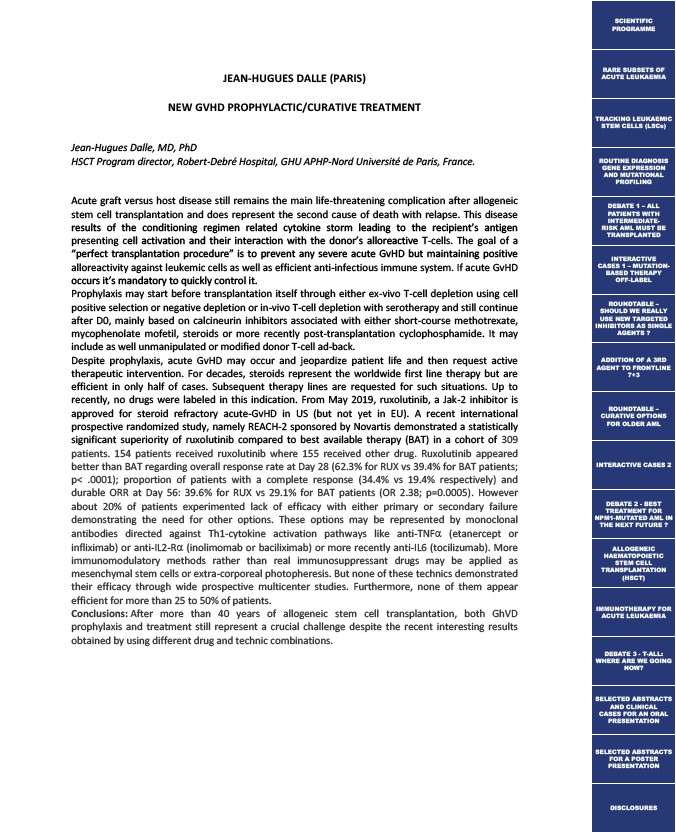
JEAN-HUGUES DALLE (PARIS)
NEW GVHD PROPHYLACTIC/CURATIVE TREATMENT
Jean-Hugues Dalle, MD, PhD
HSCT Program director, Robert-Debré Hospital, GHU APHP-Nord Université de Paris, France.
Acute graft versus host disease still remains the main life-threatening complication after allogeneic
stem cell transplantation and does represent the second cause of death with relapse. This disease
results of the conditioning regimen related cytokine storm leading to the recipient’s antigen
presenting cell activation and their interaction with the donor’s alloreactive T-cells. The goal of a
“perfect transplantation procedure” is to prevent any severe acute GvHD but maintaining positive
alloreactivity against leukemic cells as well as efficient anti-infectious immune system. If acute GvHD
occurs it’s mandatory to quickly control it.
Prophylaxis may start before transplantation itself through either ex-vivo T-cell depletion using cell
positive selection or negative depletion or in-vivo T-cell depletion with serotherapy and still continue
after D0, mainly based on calcineurin inhibitors associated with either short-course methotrexate,
mycophenolate mofetil, steroids or more recently post-transplantation cyclophosphamide. It may
include as well unmanipulated or modified donor T-cell ad-back.
Despite prophylaxis, acute GvHD may occur and jeopardize patient life and then request active
therapeutic intervention. For decades, steroids represent the worldwide first line therapy but are
efficient in only half of cases. Subsequent therapy lines are requested for such situations. Up to
recently, no drugs were labeled in this indication. From May 2019, ruxolutinib, a Jak-2 inhibitor is
approved for steroid refractory acute-GvHD in US (but not yet in EU). A recent international
prospective randomized study, namely REACH-2 sponsored by Novartis demonstrated a statistically
significant superiority of ruxolutinib compared to best available therapy (BAT) in a cohort of 309
patients. 154 patients received ruxolutinib where 155 received other drug. Ruxolutinib appeared
better than BAT regarding overall response rate at Day 28 (62.3% for RUX vs 39.4% for BAT patients;
p< .0001); proportion of patients with a complete response (34.4% vs 19.4% respectively) and
durable ORR at Day 56: 39.6% for RUX vs 29.1% for BAT patients (OR 2.38; p=0.0005). However
about 20% of patients experimented lack of efficacy with either primary or secondary failure
demonstrating the need for other options. These options may be represented by monoclonal
antibodies directed against Th1-cytokine activation pathways like anti-TNF (etanercept or
infliximab) or anti-IL2-R (inolimomab or baciliximab) or more recently anti-IL6 (tocilizumab). More
immunomodulatory methods rather than real immunosuppressant drugs may be applied as
mesenchymal stem cells or extra-corporeal photopheresis. But none of these technics demonstrated
their efficacy through wide prospective multicenter studies. Furthermore, none of them appear
efficient for more than 25 to 50% of patients.
Conclusions: After more than 40 years of allogeneic stem cell transplantation, both GhVD
prophylaxis and treatment still represent a crucial challenge despite the recent interesting results
obtained by using different drug and technic combinations.
SCIENTIFIC
PROGRAMME
RARE SUBSETS OF
ACUTE LEUKAEMIA
TRACKING LEUKAEMIC
STEM CELLS (LSCs)
ROUTINE DIAGNOSIS
GENE EXPRESSION
AND MUTATIONAL
PROFILING
DEBATE 1 – ALL
PATIENTS WITH
INTERMEDIATE-RISK
AML MUST BE
TRANSPLANTED
INTERACTIVE
CASES 1 – MUTATION-BASED
THERAPY
OFF-LABEL
ROUNDTABLE –
SHOULD WE REALLY
USE NEW TARGETED
INHIBITORS AS SINGLE
AGENTS ?
ADDITION OF A 3RD
AGENT TO FRONTLINE
7+3
ROUNDTABLE –
CURATIVE OPTIONS
FOR OLDER AML
INTERACTIVE CASES 2
DEBATE 2 - BEST
TREATMENT FOR
NPM1-MUTATED AML IN
THE NEXT FUTURE ?
ALLOGENEIC
HAEMATOPOIETIC
STEM CELL
TRANSPLANTATION
(HSCT)
IMMUNOTHERAPY FOR
ACUTE LEUKAEMIA
DEBATE 3 - T-ALL:
WHERE ARE WE GOING
NOW?
SELECTED ABSTRACTS
AND CLINICAL
CASES FOR AN ORAL
PRESENTATION
SELECTED ABSTRACTS
FOR A POSTER
PRESENTATION
DISCLOSURES